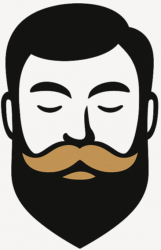
Every man’s beard tells a different story—some grow thick and full, others stay light or patchy no matter how much effort is put into care or supplements. While lifestyle and grooming certainly matter, genetics have the biggest influence on your beard’s potential. In fact, your DNA largely determines everything from growth rate to texture, density, and even color.
Here’s why genetics matter more than most people realize—and what you can still do to work with, not against, your biology.
The Science of Beard Growth
Beard growth is controlled by hormones, mainly testosterone and its more powerful derivative, dihydrotestosterone (DHT). These hormones stimulate receptors in your hair follicles, prompting them to produce thicker, darker hairs over time.
However, the amount of DHT you have isn’t the only factor—it’s how sensitive your follicles are to it. That sensitivity is inherited from your parents.
So while one man may grow a full beard with average hormone levels, another may struggle despite having plenty of testosterone, simply because his follicles respond less effectively.
What You Inherit from Your Family
If you’re wondering why your beard doesn’t look like your friend’s, look at your family tree. Beard traits are a mix of genetics from both sides:
- Density: The number of hair follicles on your face is set at birth. More follicles mean a fuller beard.
- Growth pattern: Whether your beard connects, grows in patches, or has a defined shape depends on inherited follicle distribution.
- Color and texture: It’s common to have a different beard color than your head hair due to gene variations controlling pigmentation.
- Rate of growth: Some follicles cycle faster than others, making your beard grow quicker—or slower—than average.
If your dad, uncles, or grandfathers had limited or uneven beard growth, there’s a good chance you’ll share similar characteristics.
Why Testosterone Isn’t Everything
Many men assume they can “boost” beard growth by increasing testosterone naturally or through supplements. But the truth is, if your follicles aren’t genetically receptive to DHT, raising hormone levels won’t make much difference.
Testosterone plays a role, but follicle responsiveness—not total hormone volume—is what drives beard thickness. That’s why some men with average hormone levels grow impressive beards, while others with higher levels struggle.
The Age Factor: Genetics and Timing
Beard growth also unfolds at different speeds depending on your genetic timeline. Some men grow full beards at 18, while others don’t reach their peak until their late 20s or early 30s.
This gradual development is perfectly normal—facial hair density and maturity often increase well into your 30s as hormone patterns stabilize.
What You Can (and Can’t) Change
While you can’t rewrite your genetics, you can optimize what you have. Think of beard growth like tending to a garden: you can’t control how many seeds are there, but you can control how well they grow.
What you can influence:
- Nutrition: Eat foods rich in biotin, zinc, and B vitamins to support healthy follicles.
- Circulation: Regular exercise and facial massage increase blood flow, fueling growth.
- Skin health: Exfoliate and moisturize to keep follicles clear and active.
- Patience: Growth takes time—some men need months before seeing their full potential.
What you can’t influence:
- The number of follicles you have
- How sensitive your follicles are to DHT
- Your natural beard pattern or color
By focusing on consistent care rather than shortcuts, you’ll maximize your genetic potential and improve the overall health and appearance of your beard.
Why Embracing Genetics Is Empowering
Instead of viewing genetics as a limitation, think of them as your personal blueprint. Every beard—thick, patchy, short, or wild—has its own character. What matters most is how you style and care for it.
Confidence doesn’t come from how your beard grows, but how you wear it. The most attractive beard is one that suits your natural shape and personality.
Final Thoughts
Genetics might set the stage for your beard, but you’re still the one in control of how it looks and feels. Focus on grooming, health, and patience rather than comparing yourself to others.
At the end of the day, the best beard isn’t the fullest—it’s the one that reflects who you are.
